1993 DODGE TRUCK air filter
[x] Cancel search: air filterPage 1104 of 1502
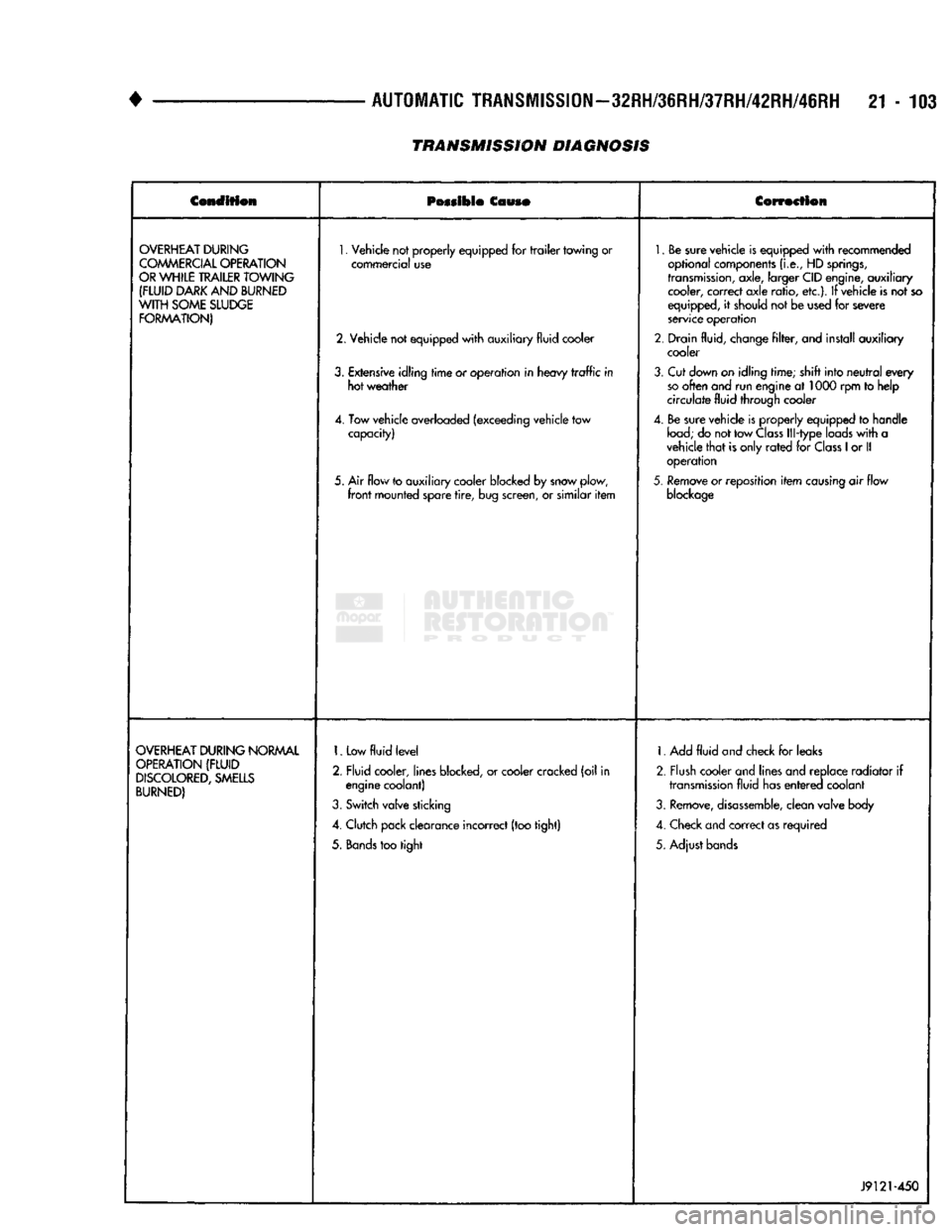
•
AUTOMATIC
TRANSMISSION—32RH/36RH/37RH/42RH/46RH
21-103
TRANSMISSION DIAGNOSIS
Condition
Possible
Couso
Correction
OVERHEAT
DURING
COMMERCIAL
OPERATION
OR
WHILE
TRAILER
TOWING
(FLUID
DARK
AND
BURNED
WITH
SOME
SLUDGE
FORMATION)
1.
Vehicle not properly equipped for
trailer
towing or
commercial use
2. Vehicle not equipped
with
auxiliary fluid cooler
3.
Extensive idling
time
or operation in heavy
traffic
in hot weather
4. Tow vehicle overloaded (exceeding vehicle tow capacity)
5. Air flow to auxiliary cooler blocked by snow plow,
front
mounted spare
tire,
bug screen, or similar
item
1.
Be sure vehicle is equipped
with
recommended
optional components
(i.e.,
HD
springs,
transmission,
axle, larger CID engine, auxiliary cooler, correct axle ratio, etc.). If vehicle is not so
equipped, it should not be used for severe
service operation
2. Drain fluid, change
filter,
and install auxiliary cooler
3.
Cut down on idling time; shift into
neutral
every
so
often and run engine at 1000 rpm to help
circulate fluid through cooler
4. Be sure vehicle is properly equipped to handle
load;
do not tow
Class
Ill-type loads
with
a
vehicle
that
is only
rated
for
Class
1
or II operation
5.
Remove or reposition
item
causing
air flow
blockage
OVERHEAT
DURING
NORMAL
OPERATION
(FLUID
DISCOLORED,
SMELLS
BURNED)
1.
Low
fluid
level
2. Fluid cooler, lines blocked, or cooler cracked (oil in engine coolant)
3.
Switch valve sticking
4. Clutch pack clearance incorrect (too tight)
5.
Bands
too tight 1. Add
fluid
and check for leaks
2. Flush cooler and lines and replace radiator if
transmission
fluid has
entered
coolant
3.
Remove,
disassemble,
clean valve body
4. Check and correct as required
5. Adjust bands
J9121-450
Page 1105 of 1502
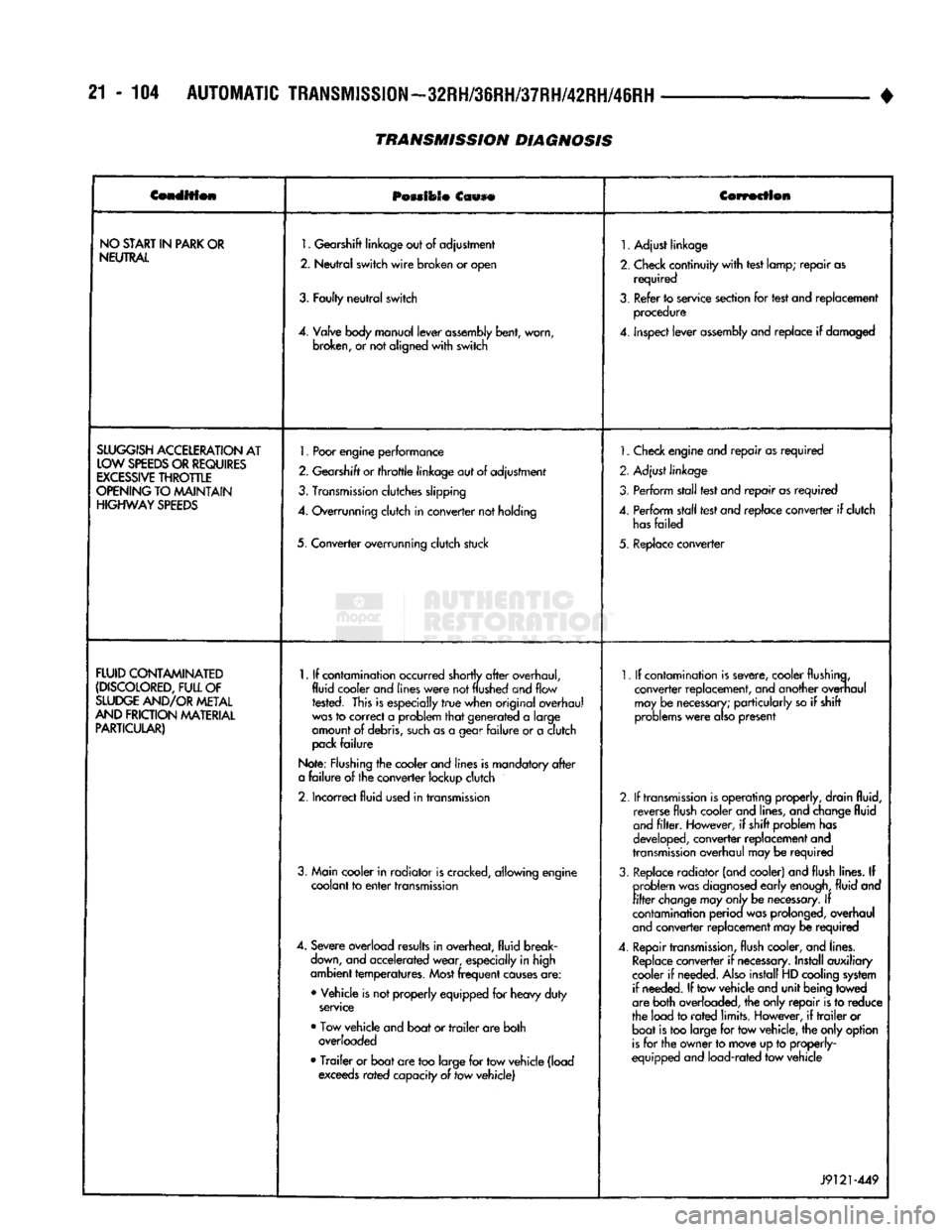
21 - 104
AUTOMATIC
TRANSMISSION—32RH/36RH/37RH/42RH/46RH
•
Condition
POMIOSO
Ccwse
Correction
NO
START
IN
PARK
OR
NEUTRAL
1.
Gearshift
linkage
out
of
adjustment
2.
Neutral
switch
wire
broken
or
open
3.
Faulty
neutral
switch
4.
Valve
body
manual
lever
assembly
bent,
worn,
broken,
or not
aligned
with
switch
1.
Adjust linkage
2.
Check continuity
with
test lamp; repair as required
3.
Refer to service section for test and replacement procedure
4.
inspect lever
assembly
and replace if damaged
SLUGGISH
ACCELERATION
AT
LOW
SPEEDS
OR
REQUIRES
EXCESSIVE
THROTTLE
OPENING
TO MAINTAIN
HIGHWAY
SPEEDS
1.
Poor
engine
performance
2.
Gearshift
or
throttle
linkage
out of adjustment
3.
Transmission
clutches slipping
4.
Overrunning clutch in converter not holding
5. Converter overrunning clutch stuck
1.
Check engine and repair as required
2. Adjust linkage
3. Perform stall test and repair as required
4.
Perform stall test and replace converter if clutch
has
failed
5. Replace converter
FLUID
CONTAMINATED
(DISCOLORED,
FULL
OF
SLUDGE
AND/OR
METAL
AND
FRICTION
MATERIAL
PARTICULAR)
1.
If contamination occurred shortly
after
overhaul,
fluid cooler and
lines
were
not
flushed
and flow rested. This is especially
true
when original overhaul
was
to correct a problem
that
generated a large
amount of debris,
such
as a gear
failure
or a clutch
pack
failure
Note: Flushing the cooler and lines is mandatory
after
a
failure
of the converter lockup clutch
2.
Incorrect fluid used in transmission
3. Main cooler in radiator is cracked, allowing engine coolant to
enter
transmission
4.
Severe overload results in overheat, fluid break
down,
and accelerated wear, especially in high
ambient temperatures.
Most
frequent
causes
are:
• Vehicle is not properly equipped for heavy duty
service
• Tow vehicle and boat or
trailer
are both overloaded
•
Trailer
or boat are too large for tow vehicle (load exceeds rated capacity of tow vehicle)
1.
If contamination is severe, cooler flushing,
converter replacement, and another overhaul may be
necessary;
particularly so if shift
problems
were
also
present
2.
If
transmission
is operating properly, drain fluid, reverse flush cooler and lines, and change fluid
and
filter.
However, if shift problem has
developed, converter replacement and
transmission
overhaul may be required
3.
Replace radiator (and cooler) and flush lines. If problem was
diagnosed
early
enough,
fluid and
filter
change
may
only
be
necessary.
If
contamination perioa was prolonged, overhaul
and
converter replacement may be required
4.
Repair
transmission,
flush cooler, and lines.
Replace
converter if
necessary.
Install auxiliary
cooler if needed.
Also
install HD cooling system if needed. If tow vehicle and unit being towed
are both overloaded, the only repair is to reduce
the load to
rated
limits. However, if
trailer
or boat is too large for tow vehicle, the only option
is
for the owner to move up to properly-
equipped and load-rated tow vehicle
J9121-449
TRANSMISSION DIAGNOSIS
Page 1131 of 1502
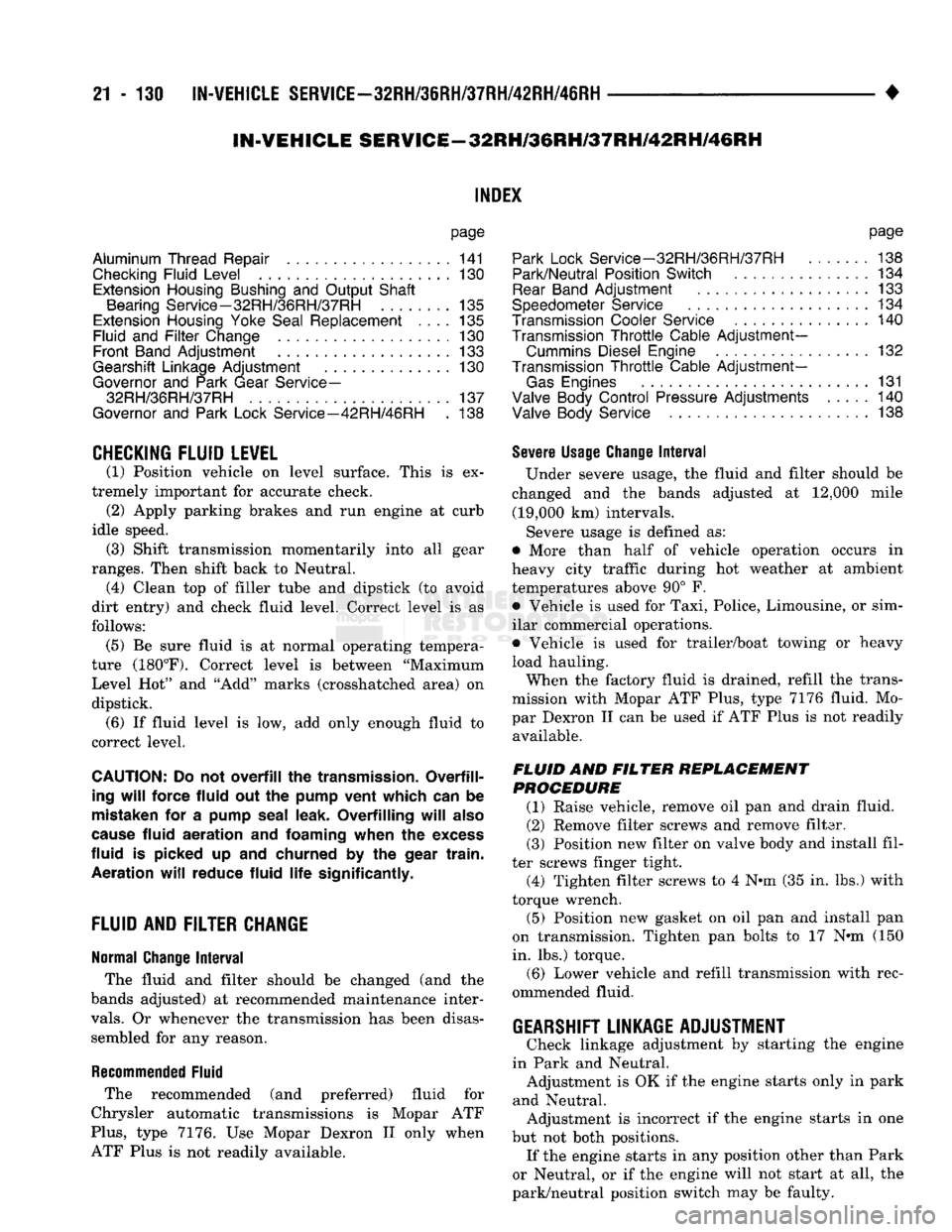
21
-
130
IN-VEHICLE
SERVICE-~32RH/36RH/37RH/42RH/4iRH
•
IN-VEHICLE
SERVICE-32RH/36RH/37RH/42RH/46RH
INDEX
page
Aluminum Thread Repair
141
Checking
Fluid
Level
130
Extension Housing Bushing
and
Output
Shaft
Bearing
Service-32RH/36RH/37RH
... .
135
Extension Housing Yoke Seal Replacement
....
135
Fluid
and Filter
Change
130
Front
Band
Adjustment
133
Gearshift Linkage
Adjustment
130
Governor
and
Park Gear Service—
32RH/36RH/37RH
137
Governor
and
Park Lock Service—42RH/46RH
.
138
CHECKING
FLUID LEVEL
(1) Position vehicle
on
level surface. This
is ex
tremely important
for
accurate check.
(2)
Apply parking brakes
and run
engine
at
curb
idle speed.
(3)
Shift transmission momentarily into
all
gear
ranges. Then shift back
to
Neutral.
(4)
Clean
top of
filler tube
and
dipstick
(to
avoid
dirt entry)
and
check fluid level. Correct level
is as
follows:
(5)
Be
sure fluid
is at
normal operating tempera
ture (180°F). Correct level
is
between "Maximum Level
Hot"
and
"Add"
marks (crosshatched area)
on
dipstick. (6)
If
fluid level
is
low,
add
only enough fluid
to
correct level.
CAUTION:
Do not
overfill
the
transmission. Overfilling
will
force fluid
out
the
pump vent which
can
be
mistaken
for
a
pump seal leak. Overfilling
will
also
cause
fluid aeration
and foaming
when
the
excess
fluid
is
picked
up
and
churned
by
the
gear train. Aeration
will
reduce fluid
life
significantly.
FLUID
AND
FILTER
CHANGE
Normal Change
Interval
The fluid
and
filter should
be
changed
(and the
bands adjusted)
at
recommended maintenance inter
vals.
Or
whenever
the
transmission
has
been disassembled
for
any
reason.
Recommended Fluid
The recommended
(and
preferred) fluid
for
Chrysler automatic transmissions
is
Mopar
ATF
Plus,
type
7176.
Use
Mopar Dexron
II
only when
ATF Plus
is not
readily available.
page
Park Lock
Service-32RH/36RH/37RH
. 138
Park/Neutral Position Switch
134
Rear
Band
Adjustment
133
Speedometer Service
134
Transmission Cooler Service
140
Transmission
Throttle
Cable
Adjustment-
Cummins Diesel Engine
132
Transmission
Throttle
Cable
Adjustment-
Gas
Engines
131
Valve Body
Control
Pressure Adjustments
.....
140
Valve Body Service
138
Severe Usage Change
Interval
Under severe usage,
the
fluid
and
filter should
be
changed
and the
bands adjusted
at
12,000 mile (19,000
km)
intervals.
Severe usage
is
defined
as:
• More than half
of
vehicle operation occurs
in
heavy city traffic during
hot
weather
at
ambient
temperatures above
90°
F.
• Vehicle
is
used
for
Taxi, Police, Limousine,
or
sim
ilar commercial operations.
• Vehicle
is
used
for
trailer/boat towing
or
heavy
load hauling. When
the
factory fluid
is
drained, refill
the
trans
mission with Mopar
ATF
Plus, type
7176
fluid.
Mo
par Dexron
II
can
be
used
if
ATF
Plus
is
not
readily available.
FLUID
AND
FILTER
REPLACEMENT
PROCEDURE
(1) Raise vehicle, remove
oil pan
and
drain fluid.
(2) Remove filter screws
and
remove filter.
(3) Position
new
filter
on
valve body
and
install fil
ter screws finger tight. (4) Tighten filter screws
to 4
N*m (35
in.
lbs.)
with
torque wrench.
(5) Position
new
gasket
on oil pan
and
install
pan
on transmission. Tighten
pan
bolts
to 17
N»m
(150
in.
lbs.)
torque. (6) Lower vehicle
and
refill transmission with rec
ommended fluid.
GEARSHIFT LINKAGE ADJUSTMENT
Check linkage adjustment
by
starting
the
engine
in Park
and
Neutral. Adjustment
is
OK
if
the
engine starts only
in
park
and Neutral. Adjustment
is
incorrect
if
the
engine starts
in one
but
not
both positions. If
the
engine starts
in
any
position other than Park
or Neutral,
or if
the
engine will
not
start
at
all,
the
park/neutral position switch
may
be
faulty.
Page 1138 of 1502
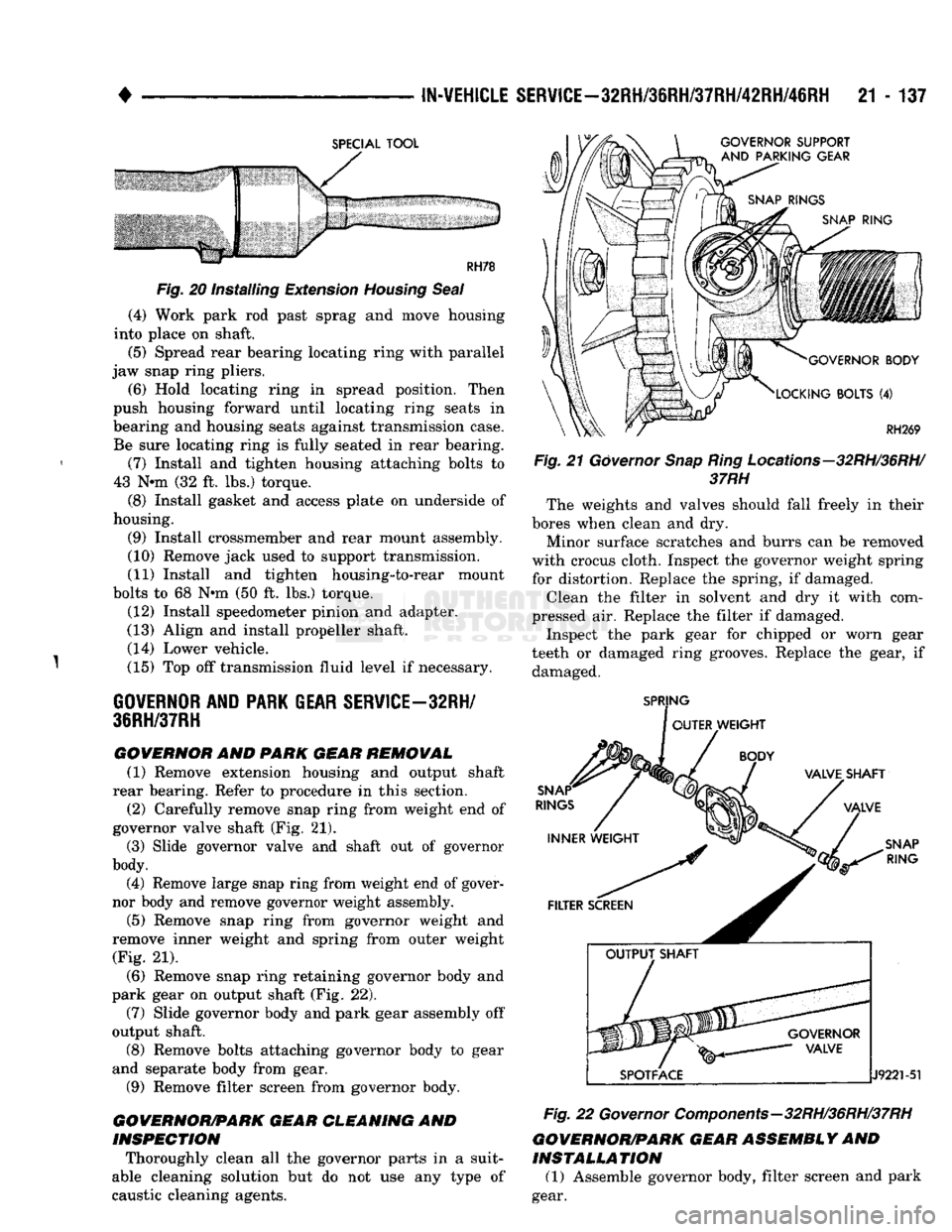
IN-VEHICLE
SERVICE-32RH/38RH/37RH/42RH/46RH
21 - 137
SPECIAL TOOL GOVERNOR SUPPORT
AND
PARKING GEAR RH78
Fig. 20 installing Extension Housing
Seal
(4) Work park rod past sprag and move housing
into place on shaft.
(5) Spread rear bearing locating ring with parallel
jaw snap ring pliers. (6) Hold locating ring in spread position. Then
push housing forward until locating ring seats in
bearing and housing seats against transmission case. Be sure locating ring is fully seated in rear bearing.
(7) Install and tighten housing attaching bolts to
43 Nnn (32 ft. lbs.) torque.
(8) Install gasket and access plate on underside of
housing.
(9) Install crossmember and rear mount assembly.
(10) Remove jack used to support transmission.
(11) Install and tighten housing-to-rear mount
bolts to 68 Nnn (50 ft. lbs.) torque. (12) Install speedometer pinion and adapter.
(13) Align and install propeller shaft. (14) Lower vehicle.
(15) Top off transmission fluid level if necessary.
GOVERNOR AND PARK GEAR SERVICE—32RH/
3SRH/37RH
GOVERNOR
AND
PARK
GEAR
REMOVAL
(1) Remove extension housing and output shaft
rear bearing. Refer to procedure in this section.
(2) Carefully remove snap ring from weight end of
governor valve shaft (Fig. 21). (3) Slide governor valve and shaft out of governor
body. (4) Remove large snap ring from weight end of gover
nor body and remove governor weight assembly.
(5) Remove snap ring from governor weight and
remove inner weight and spring from outer weight (Fig. 21).
(6) Remove snap ring retaining governor body and
park gear on output shaft (Fig. 22). (7) Slide governor body and park gear assembly off
output shaft. (8) Remove bolts attaching governor body to gear
and separate body from gear. (9) Remove filter screen from governor body.
GOVERNOR/PARK
GEAR
CLEANING
AND
INSPECTION
Thoroughly clean all the governor parts in a suit
able cleaning solution but do not use any type of
caustic cleaning agents.
GOVERNOR BODY
LOCKING BOLTS
(4)
Fig.
21
Governor
Snap
Ring
Locations-
37RH
RH269
-32RH/36RH/
The weights and valves should fall freely in their
bores when clean and dry.
Minor surface scratches and burrs can be removed
with crocus cloth. Inspect the governor weight spring for distortion. Replace the spring, if damaged. Clean the filter in solvent and dry it with com
pressed air. Replace the filter if damaged. Inspect the park gear for chipped or worn gear
teeth or damaged ring grooves. Replace the gear, if damaged.
SPRING
OUTER WEIGHT
SNAP
RINGS
INNER WEIGHT VALVET SHAFT
VALVE
SNAP
RING
FILTER SCREEN
J9221-51
Fig.
22
Governor
Components—32RH/36RH/37RH
GOVERNOR/PARK
GEAR
ASSEMBLY
AND
INSTALLATION
(1) Assemble governor body, filter screen and park
gear.
Page 1139 of 1502

21
- 138
IN-VEHICLE SERVSCE-32RH/36RH/37RH/42RH/46RH
(2) Install and tighten gear-to-body bolts finger
tight. Make sure oil passage in governor body aligns
with matching passage in gear. (3) Install assembled governor body and gear on
output shaft.
(4) Position governor body so valve shaft hole in
body aligns with matching hole in output shaft. Then slide body and park gear into place. (5) Install snap ring securing governor and park
gear to output shaft (Fig. 22).
(6) Tighten bolts attaching governor body to park
gear to 11 N»m (95 in. lbs.) torque.
(7) Assemble governor weights and spring. Secure
inner weight and spring in outer weight with snap
ring (Fig. 21).
(8) Install weight assembly in governor body and
install retaining snap ring (Fig. 21).
(9) Place governor valve on valve shaft. Insert shaft
in governor body, through governor weights and output
shaft. Be sure valve is properly seated in body.
(10) Secure valve shaft with small snap ring.
(11) Install output shaft bearing and extension
housing. Refer to procedure in this section.
GOVERNOR
AND
PARK LOCK SERVICE—42RH/
46RH
The governor and park lock components are located
within the overdrive unit and cannot be serviced in
the vehicle. The overdrive unit must be removed and disassem
bled for access to the governor and park lock compo
nents.
Refer to the 42RH/46RH overdrive unit service sec
tions for repair procedures.
PARK
LOCK SERVICE—32RH/36RH/37RH
PARK LOCK
COMPONENT REMOVAL
(1) Remove extension housing as described in this
section. (2) Slide sprag shaft out of extension housing and
remove sprag and spring (Fig. 23).
(3) Remove snap ring and slide reaction plug and
pin assembly out of housing. (4) If park rod requires service, it will be necessary
to remove valve body. Refer to Valve Body Service
procedures in this section.
COMPONENT INSPECTION
Inspect the sprag shaft for scores and free move
ment in the housing and sprag. Inspect the sprag and control rod springs for distortion and loss of tension.
Inspect the square lug on the sprag for broken
edges.
Check the lugs on the park gear for damage. Inspect the ball on the end of the control rod for
nicks and burrs. Also be sure the ball rotates freely.
J9221-249
Fig. 23
Park
Lock Components-32RH/36RH/37RH
PARK
LOCK
COMPONENT INSTALLATION
(1) Install reaction plug and pin assembly in hous
ing and secure with new snap ring (Fig. 23).
(2) Position sprag and spring in housing and insert
sprag shaft. Be sure square lug on sprag is toward
park gear. Also be sure spring is positioned so it moves sprag away from gear.
(3) Replace park rod if necessary. (4) Install extension housing as described in this
section.
VALVE BODY
SERVICE
GENERAL SERVICE
INFORMATION
The valve body can be removed for service without
having to remove the entire transmission assembly. The valve body can be disassembled for cleaning
and inspection of the individual components. Refer to
the procedures in the Transmission Unit Subassem
bly Overhaul section.
The only serviceable valve body components are
the:
• manual lever
• manual lever washer/seal/E-clip and shaft seal
• manual lever detent ball
• throttle lever
• fluid filter
• overdrive solenoid and connector assembly
• switch valve, spring and adjusting screw bracket • converter clutch solenoid The remaining valve body components are serviced
only as part of a complete valve body assembly.
VALVE
BODY
REMOVAL
(1) Raise vehicle.
(2) Remove oil pan and drain fluid.
(3) Loosen clamp bolts and remove throttle and
manual valve levers from manual lever shaft. (4) Remove park/neutral position switch. (5) Remove filter from valve body.
(6) Disconnect converter clutch solenoid wire from
case connector.
Page 1161 of 1502
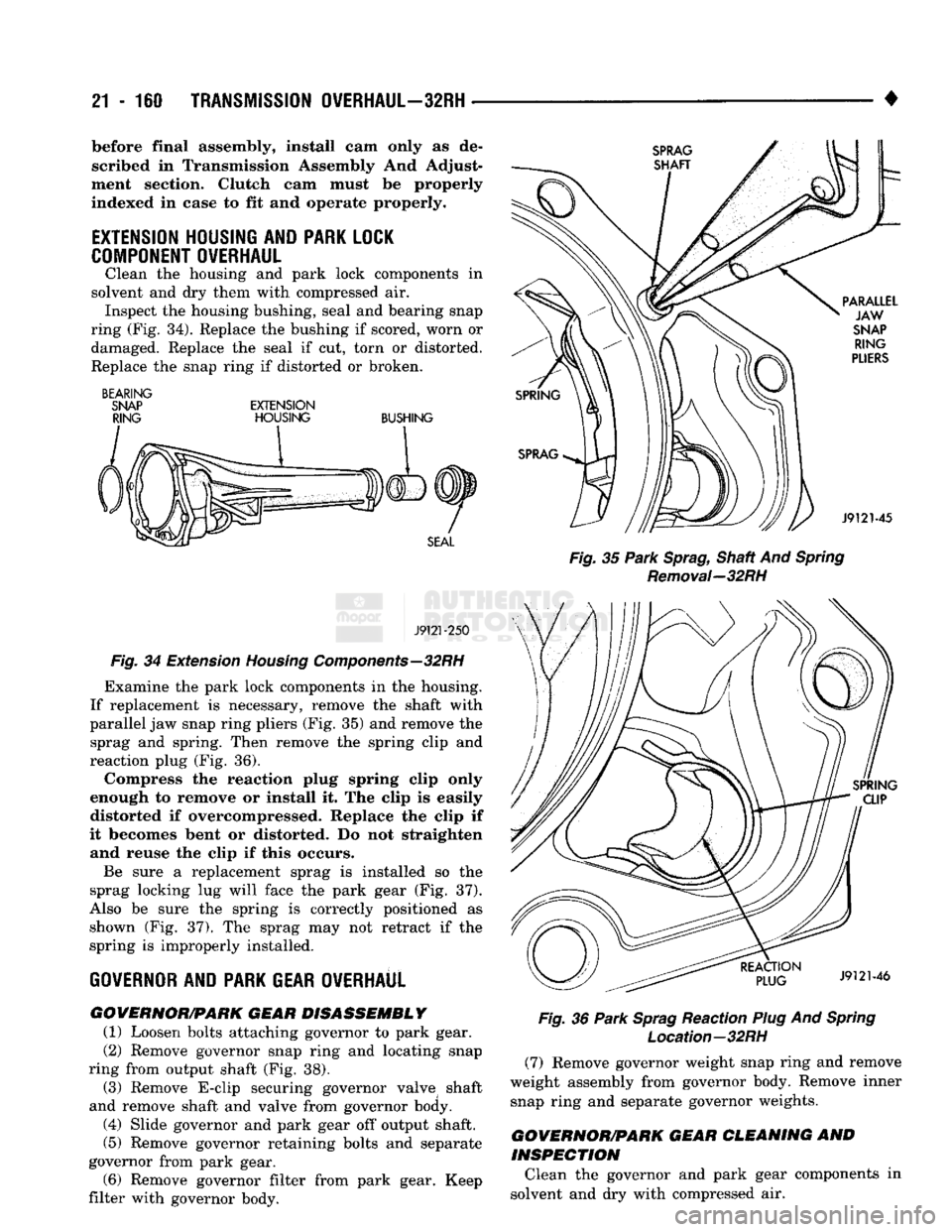
21-160
TRANSMISSION OVERHAUL—32RH
• before final assembly, install cam only as de
scribed in Transmission Assembly And Adjust
ment section. Clutch cam must be properly
indexed in case to fit and operate properly.
EXTENSION
HOUSING AND PARK LOCK
COMPONENT OVERHAUL
Clean the housing and park lock components in
solvent and dry them with compressed air. Inspect the housing bushing, seal and bearing snap
ring (Fig. 34). Replace the bushing if scored, worn or damaged. Replace the seal if cut, torn or distorted.
Replace the snap ring if distorted or broken.
BEARING
SNAP EXTENSION RING HOUSING BUSHING
J9121-250
Fig.
34 Extension
Housing
Components—32RH
Examine the park lock components in the housing.
If replacement is necessary, remove the shaft with
parallel jaw snap ring pliers (Fig. 35) and remove the sprag and spring. Then remove the spring clip and
reaction plug (Fig. 36). Compress the reaction plug spring clip only
enough to remove or install it. The clip is easily
distorted if overcompressed. Replace the clip if
it becomes bent or distorted. Do not straighten and reuse the clip if this occurs.
Be sure a replacement sprag is installed so the
sprag locking lug will face the park gear (Fig. 37).
Also be sure the spring is correctly positioned as shown (Fig. 37). The sprag may not retract if the
spring is improperly installed.
GOVERNOR
AND PARK GEAR OVERHAUL GOVERNOR/PARK GEAR DISASSEMBLY
(1) Loosen bolts attaching governor to park gear.
(2)
Remove governor snap ring and locating snap
ring from output shaft (Fig. 38). (3) Remove E-clip securing governor valve shaft
and remove shaft and valve from governor body.
(4) Slide governor and park gear off output shaft.
(5) Remove governor retaining bolts and separate
governor from park gear. (6) Remove governor filter from park gear. Keep
filter with governor body.
Fig.
35
Park
Sprag,
Shaft And
Spring
Removal—32RH
Fig.
36
Park
Sprag
Reaction
Plug
And
Spring
Location—32RH
(7) Remove governor weight snap ring and remove
weight assembly from governor body. Remove inner snap ring and separate governor weights.
GOVERNOR/PARK GEAR CLEANING
AND
INSPECTION
Clean the governor and park gear components in
solvent and dry with compressed air.
Page 1163 of 1502
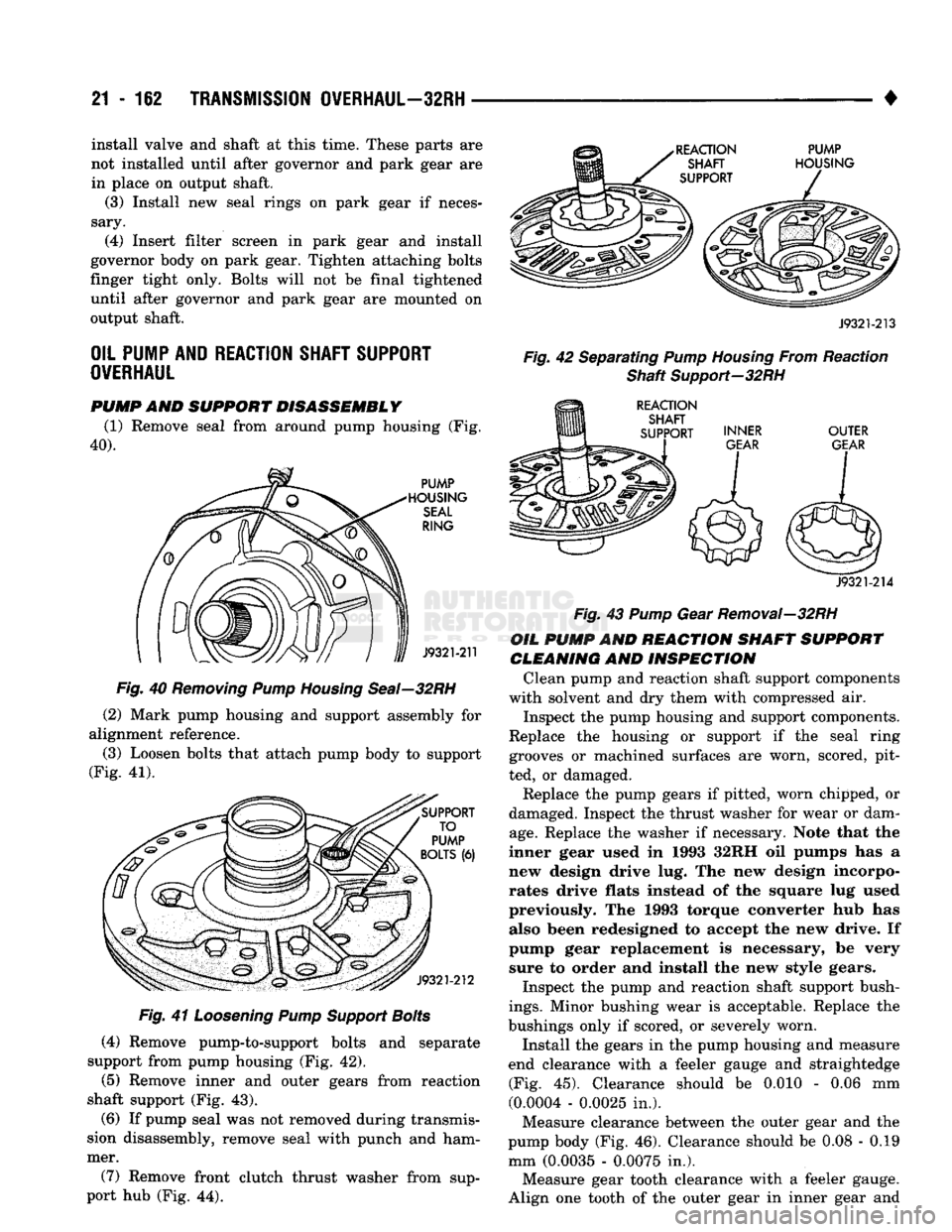
21
- 162
TRANSMISSION
OVERHAUL—32RH
• install valve and shaft at this time. These parts are
not installed until after governor and park gear are
in place on output shaft.
(3) Install new seal rings on park gear if neces
sary.
(4) Insert filter screen in park gear and install
governor body on park gear. Tighten attaching bolts
finger tight only. Bolts will not be final tightened
until after governor and park gear are mounted on
output shaft.
OIL
PUMP
AND
REACTION
SHAFT
SUPPORT
OVERHAUL
PUMP
AND
SUPPORT
DISASSEMBLY
(1) Remove seal from around pump housing (Fig.
40).
Fig.
40
Removing
Pump
Housing
Seal—32RH
(2) Mark pump housing and support assembly for
alignment reference.
(3) Loosen bolts that attach pump body to support
(Fig. 41).
Fig.
41
Loosening
Pump
Support
Bolts
(4) Remove pump-to-support bolts and separate
support from pump housing (Fig. 42).
(5) Remove inner and outer gears from reaction
shaft support (Fig. 43).
(6) If pump seal was not removed during transmis
sion disassembly, remove seal with punch and ham
mer.
(7) Remove front clutch thrust washer from sup
port hub (Fig. 44).
J9321-213
Fig.
42 Separating
Pump
Housing
From Reaction
Shaft
Support-32RH
J9321-214
Fig.
43
Pump
Gear Removal—32RH
OIL
PUMP
AND
REACTION
SHAFT
SUPPORT
CLEANING
AND
INSPECTION
Clean pump and reaction shaft support components
with solvent and dry them with compressed air.
Inspect the pump housing and support components.
Replace the housing or support if the seal ring grooves or machined surfaces are worn, scored, pit
ted, or damaged.
Replace the pump gears if pitted, worn chipped, or
damaged. Inspect the thrust washer for wear or dam
age.
Replace the washer if necessary. Note that the
inner gear used in 1993 32RH oil pumps has a
new design drive lug. The new design incorpo
rates drive flats instead of the square lug used previously. The 1993 torque converter hub has also been redesigned to accept the new drive. If
pump gear replacement is necessary, be very sure to order and install the new style gears.
Inspect the pump and reaction shaft support bush
ings.
Minor bushing wear is acceptable. Replace the
bushings only if scored, or severely worn.
Install the gears in the pump housing and measure
end clearance with a feeler gauge and straightedge (Fig. 45). Clearance should be 0.010 - 0.06 mm
(0.0004 - 0.0025 in.).
Measure clearance between the outer gear and the
pump body (Fig. 46). Clearance should be 0.08 - 0.19
mm (0.0035 - 0.0075 in.). Measure gear tooth clearance with a feeler gauge.
Align one tooth of the outer gear in inner gear and
Page 1180 of 1502
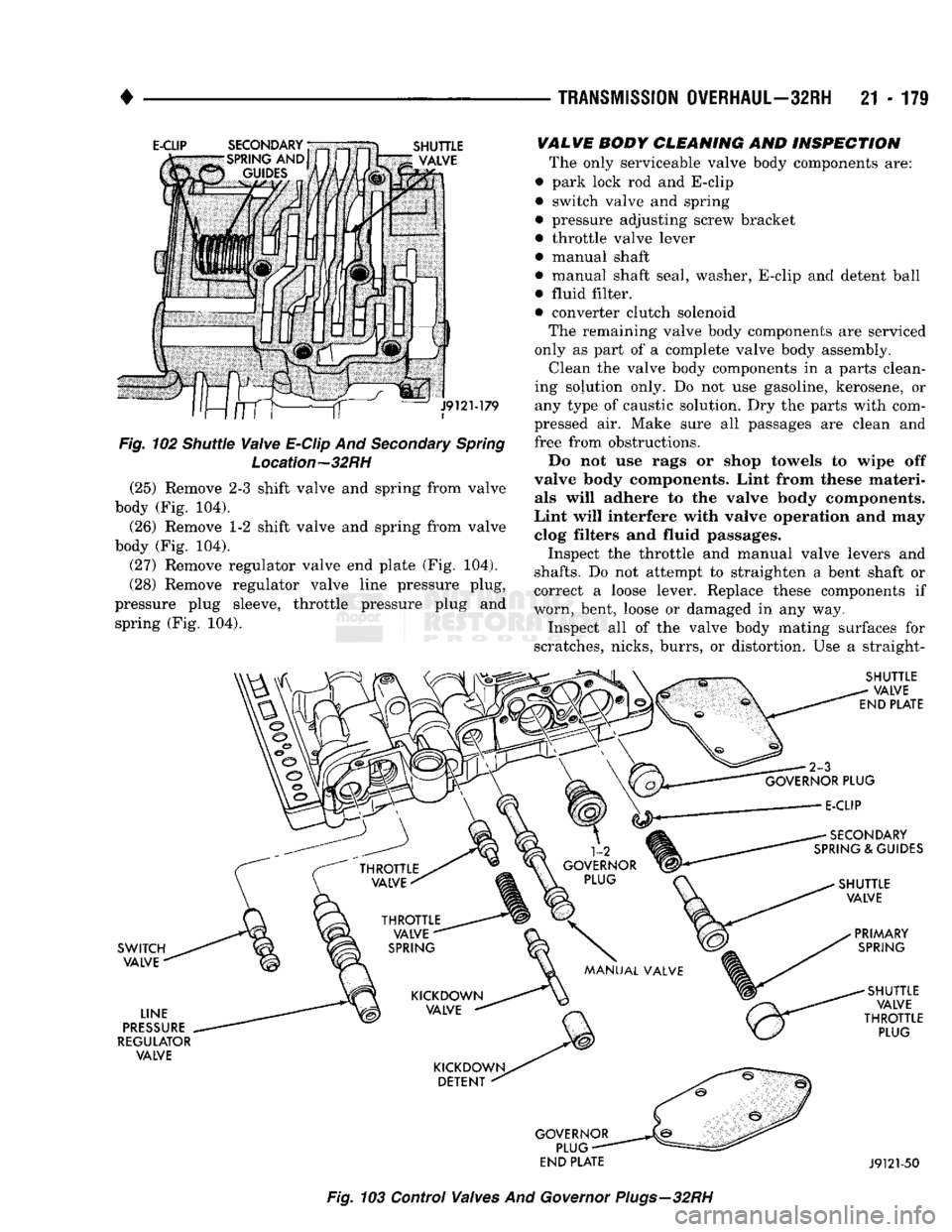
TRANSMISSION
OVERHAUL—32RH
21 - 171
E-CLIP
SHUTTLE
VALVE
Fig.
102 Shuttle
Valve
E-Clip
And
Secondary
Spring
Location—32RH
(25) Remove
2-3
shift valve
and
spring from valve
body
(Fig. 104).
(26) Remove
1-2
shift valve
and
spring from valve
body
(Fig. 104).
(27) Remove regulator valve
end
plate
(Fig. 104).
(28) Remove regulator valve line pressure plug,
pressure plug sleeve, throttle pressure plug
and
spring
(Fig. 104).
VALVE
BODY
CLEANING
AND
INSPECTION
The only serviceable valve body components
are:
• park lock
rod and
E-clip
• switch valve
and
spring
• pressure adjusting screw bracket • throttle valve lever
• manual shaft
• manual shaft seal, washer, E-clip
and
detent ball • fluid filter.
• converter clutch solenoid
The remaining valve body components
are
serviced
only
as
part
of a
complete valve body assembly.
Clean
the
valve body components
in a
parts clean
ing solution only.
Do not use
gasoline, kerosene,
or
any type
of
caustic solution.
Dry the
parts with com
pressed
air.
Make sure
all
passages
are
clean
and
free from obstructions.
Do
not use
rags
or
shop towels
to
wipe
off
valve body components. Lint from these materi als will adhere
to the
valve body components.
Lint will interfere with valve operation
and may
clog filters
and
fluid passages.
Inspect
the
throttle
and
manual valve levers
and
shafts.
Do not
attempt
to
straighten
a
bent shaft
or
correct
a
loose lever. Replace these components
if
worn, bent, loose
or
damaged
in any way.
Inspect
all of the
valve body mating surfaces
for
scratches, nicks, burrs,
or
distortion.
Use a
straight-
SHUTTLE
VALVE
END
PLATE
SWITCH
VALVE
LINE
PRESSURE
REGULATOR
VALVE
SECONDARY
SPRING
&
GUIDES
SHUTTLE
VALVE
PRIMARY
SPRING
SHUTTLE
VALVE
THROTTLE
PLUG
GOVERNOR
PLUG-
END
PLATE
J9121-50
Fig.
103
Control Valves
And
Governor
Plugs—32RH